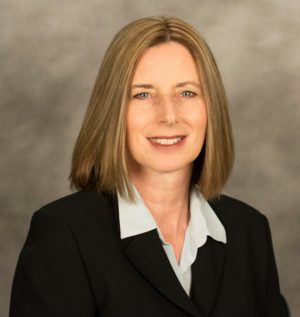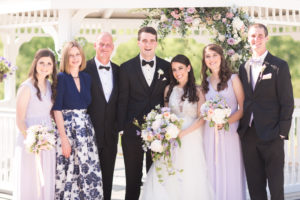Education: Ph.D., Vanderbilt University, Chemistry.
M.S., Vanderbilt University, Chemistry.
B.S., Kentucky Wesleyan College, Chemistry and Mathematics.
Fellowship: Hospital of the University of Pennsylvania, Philadelphia, Magnetic Resonance Imaging.
Dr. Schuster was a member of a team that discovered Creatine Transporter Deficiency Syndrome, a genetic disorder, in 2000.

“Induction into the Hall of Fame reunites me with my alma mater. My time at Wesleyan was preparation for successful entry into the world. I had to venture far from Wesleyan and Owensboro to conduct the research I have done in my career. It is nice to come home, and I am very honored by the recognition.”
The Alumni Hall of Fame perpetuates the memory of those who have brought distinction to the name and reputation of the College. The Class of 2017 honors four individuals: Lydia Dorman ’82, Rep. Walter (Jody) Richards ’60, Dr. Kim M. (Cecil) Schuster ’88 and A.J. Smith ’71. Each month from now through October, The Wesleyan Way will feature one of the inductees. The Alumni Hall of Fame Induction and Awards Dinner will be hosted at the Owensboro Convention Center on Saturday, Oct. 7, as part of Homecoming 2017.
Why did you attend Wesleyan?
“I prayed to God that He would open the doors He wanted me to go through for my life, and the door to Kentucky Wesleyan swung fully open. Everyone was so friendly when I came for a visit. I was awarded a James Graham Brown scholarship to cover tuition, and that was a game changer for me.”
How did Wesleyan help prepare you for your future?
“The information content is fairly similar across colleges and universities, and the knowledge you obtain depends primarily on you and your professors. Many professors, especially Drs. W.L. Magnuson and Dan Bradshaw, offered encouragement. I had no confidence when I arrived and was undecided on a career path. I was also a first generation college student. They believed in my abilities, which provided a great foundation for my future education and career. Dr. Magnuson took students to Vanderbilt University to view the graduate program in chemistry several times, which is why I decided to further my education there.”
What does induction to the Alumni Hall of Fame mean to you?
“I am very honored. This induction reunites me with Kentucky Wesleyan. My time at the College was excellent preparation for successful entry into the world. I had to venture far from Wesleyan and Owensboro to conduct the research I’ve done. It is nice to come home and be recognized.”

What is a typical day in the workplace for you?
“A typical day involves a combination of collecting patient or research participant data on the magnetic resonance imaging (MRI) scanner, post-processing the data myself or supervising a student doing it, time reviewing literature, writing up results for presentation or paper and writing grant applications. I am on a few committees, some of which I chair, so as I get older, more of my time is spent with administrative activities. I am asked more and more for advice and mentorship and spend more time transferring knowledge to junior faculty, especially women.”
What is Creatine Transporter Deficiency Syndrome, and what was this discovery significant?
“Our bodies make creatine and take it in from foods such as fish, red meats, cranberries and milk, and use it to regulate energy in all of our cells. The X-chromosome produces the transporter, which allows creatine to go from our blood to the brain. When the transporter is defective, especially in boys, the cells in the brain do not function properly. This can result in severe intellectual disability, developmental delay, severe language impairment and autistic-like features. I identified the first patient with this disorder using magnetic resonance spectroscopy (MRS) of the brain during an examination. Over the past 18 years, over 150 people have been identified with the disorder internationally. Researchers in Cincinnati have created two mouse models in which the disease has been produced in mice to better understand the disorder and evaluate therapies. One promising therapy is currently being evaluated for the eventual treatment in patients.”
What is your greatest professional accomplishment?
“I was recently featured in a NOVA episode on PBS (‘Poisoned Water. The story behind the Flint, Michigan, water crisis”).
I think my greatest accomplishments professionally are yet to come. My primary research projects over the last 15 years have focused on understanding how environmental exposures affect the developing brain. While some of the work has focused on children and adults with elevated levels of lead and manganese, more recent studies focus on common exposures to air pollution, flame-retardants and non-stick coatings in typically developing populations in the Midwest. The science from these epidemiological studies of children and adults will be useful for guiding public policy in the future. Determining if some environmental regulations are at appropriate levels or if they need refinements will eventually impact our nation and the world.”
Tell us about your family.
“My parents, sister and nephews continue to live in Owensboro. My sister, Dawn (Cecil) Ralph ’04, and oldest nephew, Trevor Ralph, graduated from Wesleyan as well. My youngest nephew, Jared Ralph, will matriculate this fall.
As I mentioned, I asked God to open doors for me. While my heart’s desire was to become a wife and mother, it just never seemed to work out. My grandmother always said I was too picky. However, God had a plan, and I just had to wait until the time was perfect. In 2006, I had accepted a faculty position to begin January 2007 in San Francisco. I went on a ‘practice’ date in November 2007 with a man whose career was in finance and had four children. I thought there was no likelihood this would work out, but thought, ‘Hey, you’re 39, and it’s a nice dinner.’ Long story short, I stayed in Cincinnati, married him the following June and became a mother to four children, ages 8-16 at the time. This past summer, our oldest son graduated medical school and married and our youngest daughter graduated high school. We are about to become empty nesters, and finally have some alone time together! We envision trips to cool places, ATV trail riding and discovering the next phase of our lives.”
Learn more about her work at the Imaging Research Center at Cincinnati Children’s Hospital Medical Center here.

